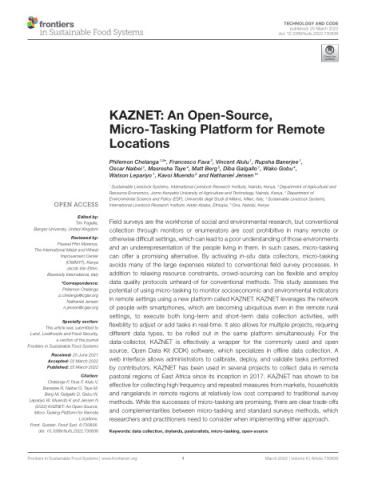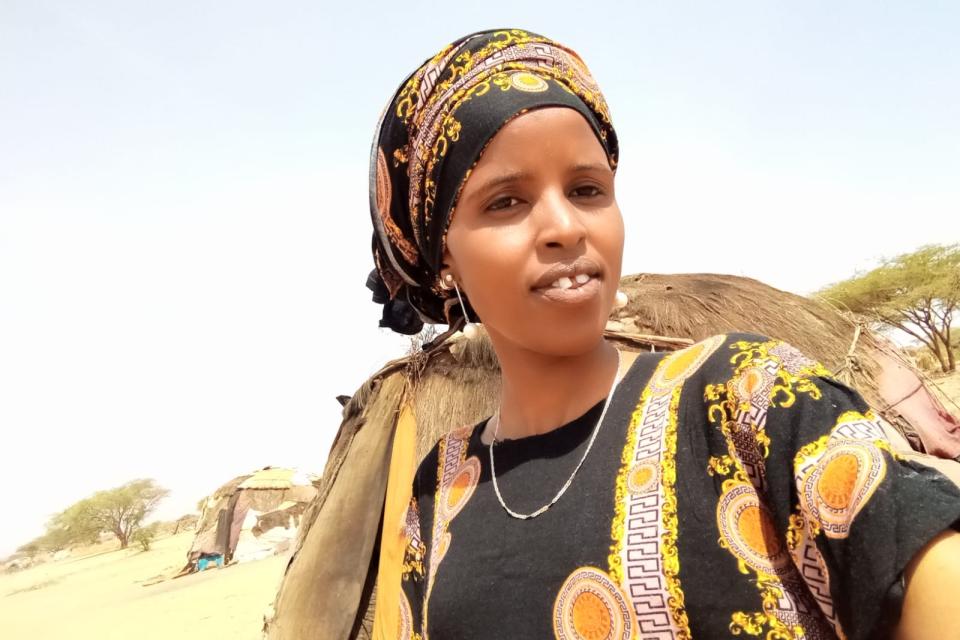

Beyond smartphones: How citizen volunteers are supporting a drylands livestock market intelligence platform in Kenya
By leveraging the power of citizen volunteers, KAZNET, a digital livestock market intelligence platform, is setting a new standard for how local knowledge backed by digital technology can bridge the economic gap in Kenya’s arid regions.
At the core of KAZNET's success is more than 50 citizen volunteers, aptly named ‘contributors,’ spread across Kenya’s dryland counties and responsible for inputting key data into the platform and disseminating information to local communities.
In the drylands of Kenya, the digital transformation of livestock markets is gathering pace, and contributing to that is a platform named KAZNET, developed by the International Livestock Research Institute (ILRI) with support from USAID and FCDO, and scaled through Accelerating Impacts of CGIAR Climate Research for Africa (AICCRA) project, Supporting Pastoralism and Agriculture in Recurrent and Protracted Crises (SPARC) project and the CGIAR Research Initiative on Livestock and Climate.
KAZNET provides demand driven market intelligence for livestock keepers in arid and semi-arid lands (ASALs) of Kenya and Ethiopia. This platform is now integrated into the Government-led Kenya Agricultural Observatory Platform (KAOP) managed by the Kenya Agricultural Livestock Organization (KALRO) to enhance the delivery of real-time livestock market data, supplementing the Kenya Integrated Agricultural Management Information System (KIAMIS).
Livestock at a community water point in Northern Kenya
At the core of KAZNET's success is the involvement of about 52 citizen volunteers, aptly named ‘contributors,’ spread across Kenya’s dryland counties. These contributors are responsible for inputting key data into the platform and disseminating that information to local communities.
Abdiaziz Ibrahim Bulle, a livestock keeper and trader from Ngare-Mare, Isiolo County, began his journey with KAZNET in June 2023 as a regular contributor, tasked with monitoring market prices, livestock quality, and traded volumes.
“The information we generate helps livestock keepers make informed decisions on when and where to buy or sell their livestock at the best price and where to find suitable grazing areas,” explains Abdiaziz.
Thus, for livestock keepers like Abdiaziz this information is not just data; it’s a lifeline.
Super contributors: the critical link
Within this network of contributors lies a select group referred to as ‘super contributors,’ who undergo specialized training and have enhanced roles. Acting as the bridge between ILRI and the regular contributors, super contributors play a pivotal role in verifying data and ensuring its accuracy. Over a year ago, Abdiaziz Ibrahim Bulle, was promoted from a regular contributor to a super contributor and under him are 26 contributors.
“As a super contributor, I validate the data entered by others. I ensure that the information entered in the system matches with reality on the ground and I either approve or reject the data based on its quality,” Abdiaziz explains.

A livestock trader checking the vitality of a cow during price negotiations.
The contributors are charged with monitoring four key indicators:
- Rangelands: Monitoring pasture availability and suitability for grazing
- Market Prices: Providing detailed data on livestock prices, body condition, and traded volumes
- Household Conditions: Tracking coping strategies, dietary diversification and the nutrition status of children and primary caregivers
- Livestock Metrics: Measuring birth and death rates, as well as milk productivity
Another super contributor, Peter Lesirangongu from Loiyangalani, Marsabit County, shares how his role goes beyond just data validation.
“I help train community members on the KAZNET platform, I help them to download the app and show them how to access information from the system.”
Boru Dabasso, livestock keeper from Burgabo, Marsabit County
How KAZNET is supporting livestock keepers
Apart from the contributors, the other strength of KAZNET lies in its demand-driven approach.
The information the platform gathers is based on the needs of the community, assessed through surveys, and this changes from time to time and from one location to another. Information from KAZNET further helps in monitoring drought and provides early warnings.
“Our data gathering system attempts to close loopholes from other market information systems. For example, the system is geo-fenced when gathering market information. As such, contributors cannot input market information unless they are physically in the location of the specific market assigned to them, and in addition they are required to backup their input by providing photo evidence,” explains Dr. Kelvin Shikuku, ILRI scientist and economist.
Empowering women and addressing gender-related challenges
KAZNET has also grown its reach through efforts to include women in the dissemination of information. Many community groups targeted by the contributors are women-led, and while smartphone access remains a challenge for some, alternative dissemination methods combining digital innovation via KAZNET with social learning within the pastoralist groups ensure they are not left behind. KAZNET information is currently disseminated to about 450 pastoralist groups in Kenya, each comprising 10 members, on average.

Peter Ighalo, a 'super contributor' collecting household information.
Charting the future: the potential of KAZNET
With support from the AICCRA project, KAZNET is expanding its reach and impact across Kenya's drylands. This support includes enhancing the capacity of pastoralists and partners through skill-building initiatives, broadening livestock market information access, and adding new functionality to the KAZNET platform. One exciting development is the integration of user-friendly information dissemination dashboards into the platform.
As KAZNET continues to grow, it is shaping up to be a crucial tool for Kenya’s dryland communities, particularly in its five focus counties: Marsabit, Samburu, Isiolo, Garissa, and Wajir. The platform empowers communities with critical data on rangeland conditions, livestock markets, and coping strategies helping to mitigate the impacts of drought and build long-term resilience.
By leveraging the power of citizen volunteers, KAZNET is setting a new standard for how local knowledge backed by digital technology can bridge the economic gap and improve lives in Kenya’s arid regions.
Acknowledgements
ILRI Livestock and Climate Initiative is supported through the CGIAR Trust Fund, while AICCRA is supported by a grant from the International Development Association (IDA) of the World Bank Group.
Authors
Polycarp Otieno Onyango, Communications Lead, AICCRA Kenya
Dr. Kelvin Shikuku, Scientist, International Livestock Research Institute (ILRI)


